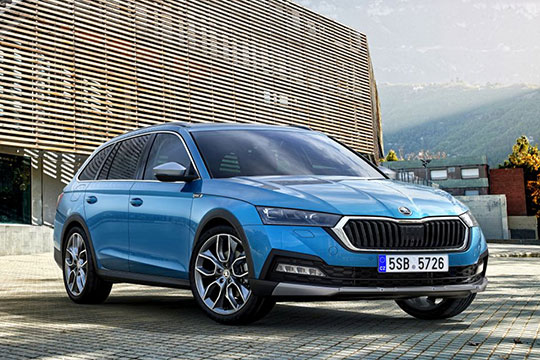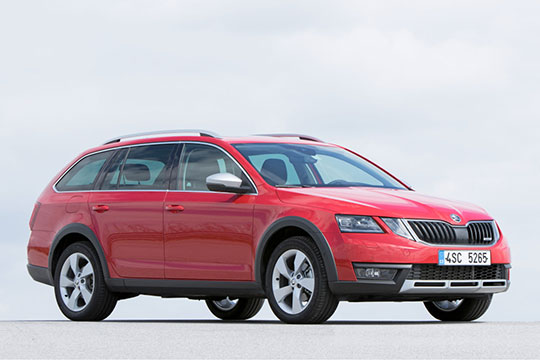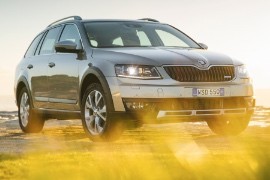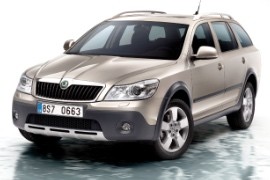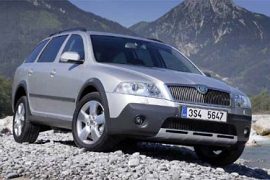SKODA Octavia Scout Models/Series Timeline, Specifications & Photos
First production year: 2006
Engines: Gasoline, Mild hybrid, Diesel
The Czech brand introduced the Octavia Scout in 2020, along with the rest of the Octavia range in a completely online event due to the world pandemic situation.
The fourth generation of the Octavia offered more interior room and a new image. The car was built on the MQB Evo platform, which allowed a better integration for the mild-hybrid and hybrid versions. The Scout trim level was, just like its predecessors, a heightened and rugged version for the regular Octavia station-wagon.
The new model featured a broader and shorter grille at the front. The designers chose the cubism style for the Octavia, and it was translated on the Scout version as well. Both bumpers and the side-sills were fitted with black plastic trims to protect the underbody from chips. A fake silver plastic shield enhanced the look of the front bumper. The black plastic molds on the wheel-arches were already a typical design cue of the Octavia Scout and found their way onto the 2020 model.
The interior of the car was the same as the rest of the Octavia range. The interior design was specific for the trim level, with a mix of wood and green trims around the dashboard and the door panels. A 10” infotainment touch-screen display found its way on top of the center stack, in a free-floating design. Like its predecessors, the 2020 Octavia Scout offered more comfort due to the heated steering wheel and seats.
Under the hood, Skoda installed a choice of turbocharged diesel or gasoline engine. The big news was about the traction system. For the first time, the Scout version was available as a 2WD only, for specific engines.
Skoda introduced the Scout trim level on the Octavia range in 2007, and due to its commercial success, it was introduced on its successors.
Skoda introduced the third generation of the Octavia in 2012, and it was a clear move into the mid-sized class from the compact-sized vehicles as it was in the first two generations. Five years later, along with the facelifted model, the Czech brand introduced the Scout level.
The Octavia was longer and wider than its predecessor, and it featured a few details that made the car clever. An ice-scraper in the fuel flap or the double floor mat in the trunk were just some examples. Octavia Scout was available only as a station-wagon, and it featured a higher ground clearance than the non-Scout siblings. The "off-road" stance was enhanced by plastic molds around the wheel-wells and a silver shield under the front bumper. Both bumpers featured black aprons with hard plastic to cope better with stones-chips. The Scout version featured standard 17" light-alloy wheels.
Inside, the Octavia Scout featured a raised seating position for better visibility around the car while going on unpaved roads. It was more of a crossover vehicle, not an off-road one. For cold weather, Skoda offered the heated steering wheel and seats as a standard feature. The instrument cluster was carried-over from the regular Octavia.
Under the hood, the Octavia Scout was offered with a choice of three engines: one gasoline and two versions of the same 2.0-liter turbodiesel unit. All versions sent the power in all corners via a Haldex center differential. Depending on the engine version, a 6-speed automatic (DSG) or a 6-speed manual was standard.
Skoda introduced the Octavia's third generation in 2012 as a hatchback and a station wagon and three years later brought the Scout version for the latter.
With a rising demand for SUVs and crossovers, Skoda returned on the market with the Scout version for Octavia Combi and brought introduced more lifestyle fragrances in the process. It wasn't a true off-road vehicle, but it was good enough to cope with unpaved, snowy, or loose surfaces.
While the bodywork kept the same shape designed by Jozef Kaban, the bumpers and lower area went through a re-styling process. Its lower side of the bumper was black, and an aluminum shield found its place underneath the engine compartment to protect it from bumps and scratches. On its sides, the plastic moldings on the wheel-arches visually enhanced the off-road character of the car. In the back, a silver plastic shield enhanced the look of the bodywork.
Inside, Skoda installed the same interior as the one existing in the Octavia Combi (station wagon) with sport bucket seats at the front and a 60/40 split-folding rear bench seatback. The carmaker placed a color display between the speedometer and tachometer on the instrument cluster, while the fuel and temperature gauges were included at the bottom of the main dials.
Under the hood, Skoda installed a choice of three engines, all turbocharged. The all-wheel-drive system (Haldex) was included in the Scout package, while the seven-speed (dual-clutch) automatic transmission was available as an option for the standard six-speed manual.
Skoda introduced a facelift for the entire Octavia range in 2008, but the times were harsh, so it waited a year more to unveil the crossover version, named Scout.
With an economy that was starting to get back on its feet again, the Czech carmaker Skoda decided to make a bold step and launched the Scout version for the Octavia. It was a crossover vehicle that shared most of its parts with the rest of the Octavia range and other cars from the Volkswagen Group. The car was built on the same PQ35 platform as the VW Golf Mk 5 or the Audi A3.
Unlike the rest of the Octavia range, the Scout featured a higher ground clearance and offroad-inspired details. At the front, the bumper sported a black lower area and a plastic shield. The car was slightly longer, taller, and broader than the regular Octavia Combi (station wagon) due to specific items installed on it to make it look rugged.
Inside, the Scout featured a similar interior as its non-Scout version, but with leather upholstery and a bigger, refrigerated center console. Also, the front passenger received a handle mounted on the dashboard, like in older, prestigious off-road vehicles. Since the carmaker installed a Haldex all-wheel-drive system that didn't take space from the passengers' area or the trunk, which remained at the same high level of 605 (21.4 cu-ft) liters with the rear split-bench up, or 1,655 liters (58.4 cu-ft) with that folded.
Under the hood, Skoda offered a choice of two engines for the Scout: turbocharged gasoline and turbo-diesel. It paired them as standard to a six-speed manual, while a six-speed automatic was an option for the oil-burner version.
Hitting the showrooms in 2007, the redesigned Octavia was meant to improve its off-road capabilities and it was produced under the nameplate of Octavia Scout.
The Scout was longer, wider and higher than the Skoda Octavia 4x4. The ground clearance was also higher by 17 mm.
The exterior design was heavily modified with new front and rear bumpers, as well as side protection strips and door sill covers.
The Scout came with roof rails and 17-inch alloy wheels to enhance the practicality.
The interior of the Scout was comfortable, with leather-wrapped steering-wheel and gear stick knob. Optionally, users could choose stainless stieel non-slip surfaces for the pedals.
The roomy interior offered great space for both the front and rear passengers.
The Octavia Scout was equipped with a Haldex four-wheel-drive system that excelled in the most difficult road conditions.
Available with two engine options, the Scout could be equipped with a 2.0-liter gasoline with 150 hp or a 2.0-liter turbodiesel powerplant producing 140 hp.
The Scout offered more off-road capability than a regular Octavia and better economy and handling than an SUV.
A roomy Jumbo Box was offered as a storage unit placed under the front armrest.
Standard features also included entry lights in the external mirrors and a light assistant.
